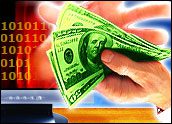Since the 1990s, the expansion and popularity of the Internet have created a new way of buying and selling online (e-commerce). Most people expect that one day, paper money will no longer be a method of payment in transactions.
What is Electronic Money?
 Electronic money began to be used in the late 1990s, based on predictions about the number of customers using credit cards for purchases. The conversion of paper money to electronic money (e-money) seemed to be an attractive solution.
Electronic money began to be used in the late 1990s, based on predictions about the number of customers using credit cards for purchases. The conversion of paper money to electronic money (e-money) seemed to be an attractive solution.
|
Definition: Electronic Money Electronic money (e-money or digital cash) is a system that allows users to make payments when purchasing goods or services by transmitting numbers from one computer to another. Similar to serial numbers on paper money, the serial number of electronic money is unique. Each “note” of electronic money is issued by a bank and represents a certain amount of real money. The characteristic feature of electronic money is similar to real paper money; it is anonymous and can be reused. This means that the buyer will pay a certain amount to the seller without any means of retrieving information about the buyer. This is also a distinctive feature between electronic money and credit card payment systems. |
During this time, the first activities of electronic money began to invade the Web. However, this type of currency was still minimal compared to the use of credit cards. Primarily used for online transactions, these currencies were issued by companies like Beenz.com, Flooz.com, and several others.
However, during the recession of 2000, many “dot-com” companies were established but quickly collapsed and became “dot-bombs.” As a result, electronic money remained a matter to be carefully considered and reviewed.
Japan: A Flourishing Electronic Money Market
Today, Japan has about 15 million electronic money users. For these individuals, paper money is a thing of the past. Paper money is rarely used for online shopping; electronic money is accessed via smart cards or mobile phones, becoming a lifestyle choice for consumers in Japan.
In Japan, electronic money began four years ago and was initially known as a service for paying monthly transportation fares. Today, it is integrated into smart cards and mobile phones for shopping at small vendors, large stores, restaurants, and supermarkets. According to research institutes in Japan, by 2008, there would be around 40 million users—meaning that about one-third of the population would use electronic money.
The Japanese Economic Monthly reported that last year, NTT DoCoMo—the largest telecommunications company in Japan—sold 3.34 million handheld devices equipped with FeliCa technology since April 2005. In 2005, the revenue from electronic transactions doubled. Some large supermarkets in Japan reported that 40% of their transactions used electronic money.
How is Electronic Money Used in the U.S.?
How is the United States— the largest economy in the world and a global high-tech center—transforming its approach?
Senior analyst at Yankee Group, Joe Levine, is skeptical that paper money or coins will soon “disappear”: “Creating an American society that solely uses mobile phones and smart cards requires a significant effort and contribution from credit card providers, mobile service providers, manufacturers, and retailers… Japan’s progress has been substantial due to companies like DoCoMo capturing a significant market share in this industry. For instance, DoCoMo only needed to invest $900 million to acquire a 34% stake in Sumitomo Mitsui Card—the second-largest credit card company in Japan. Subsequently, this credit card issuer began developing payment machines and ATMs compatible with DoCoMo’s handheld devices.“
Charles Goldfinger, a senior consultant on finance and financial applications based on smart cards, agrees with this perspective: “DoCoMo appears to have a monopoly in this market, with nearly 50 million subscribers, making electronic money very successful in Japan. The telecommunications market in the U.S. is entirely different. In reality, the U.S. telecommunications market is dominated by a few providers, making the implementation of electronic money quite challenging.“
Currently, Cingular is conducting trials of an electronic money system at the Philips Arena in Atlanta, home to the Hawks and Thrashers. This service utilizes Nokia mobile phones equipped with Philips’ NFC technology, ready for around 250 fans of the teams. These fans need to have a Visa account at Chase Bank and can then use their mobile phones to purchase tickets and enter the arena to support their team.
Following this, credit card issuers are also launching contactless credit cards such as Blink from Chase, PayPass from MasterCard, Contactless from Visa, and Express Pay from American Express. These cards, using integrated NFC chips, can prevent theft and signature forgery. Instead, users simply need to hold their card up to the reader for the transaction to be completed. To learn more about NFC technology, you can refer to the article: NFC: The New Technology Turning Mobile Phones into Electronic Wallets
Saying “Goodbye” to Paper Money?
However, upgrading payment systems will incur investment costs for businesses. This is similar to the chicken-and-egg problem. Businesses are often “reluctant” to invest in technology that would provide convenience for customers. Moreover, customers tend to be cautious when using new technologies.
This has led to the limited success and support for electronic money. Just like how paper money coexisted after the introduction of checks. Thus, the likelihood of paper money coexisting with electronic money remains high. In particular, electronic money cannot completely eliminate credit cards and debit cards.
Electronic money will also need more time to mature. As telecommunications companies transition to 3G technology, it will provide the necessary infrastructure to support mobile online transactions. At that point, electronic money will truly “take off,” becoming a strong backbone for e-commerce.
Minh Phuc


















































